How to Get Remote Access to a Pc for Continued Use
Remote Access via Desktop | |
| If your question is not addressed below, please contact us through our feedback form and we'll get back to you shortly. | |
| General | |
| | What is RemotePC? |
| | What are 'Computer Name' and 'Personal Key'? |
| | What are the checks to be made before connecting to a remote computer? |
| | Which version of Mac OS X is supported for the RemotePC application? |
| | Which distributions/versions of Linux OS are supported for the RemotePC application? |
| | Do I need a monitor to remotely access a Linux server? |
| | Can I remotely access a Linux machine running on Wayland desktop session? |
| | Can I launch the RemotePC Linux application at the root level? |
| | How can I avoid my remote Linux machine from going offline after reboot? |
| | Can I access my Raspberry Pi computers with RemotePC? |
| | Do I need to pre-authorize RemotePC in Mac OS Mojave for remote access? |
| | How do I pre-authorize RemotePC in Mac OS Catalina for remote access? |
| | How do I pre-authorize RemotePC in Mac OS Catalina for access to files and folders? |
| | On trying to install the RemotePC Windows application I'm getting the message "The App You're Trying To Install Isn't A Microsoft-Verified App". What should I do? |
| | What are the options available in the RemotePC tray? |
| | What are the different states of RemotePC? |
| | What should I do to restart a remote computer? |
| | What happens when I clone computers and VMs with RemotePC pre-installed? |
| Access | |
| | How do I get started with RemotePC? |
| | How do I configure my computer for remote access? |
| | How do I view and access my remote computers? |
| | Can multiple simultaneous connections be established with the same remote computer? |
| | Can I remotely access a Mac from a Windows or Linux computer? |
| | How do I connect to a specific RDP Session on a server? |
| | What do the options under 'Always-ON Remote Access' tab signify? |
| | I forgot the Personal Key of my computer. How can I reset it? |
| | How do I clear stored personal key credentials from the desktop application? |
| | How do I disconnect a remote session on a Linux machine? |
| | Can I share a computer with my users? |
| View | |
| | Can I scale the remote computer's desktop screen to fit within my local computer window? |
| | Can I switch between multiple monitors of the remote computer? |
| | Does RemotePC support multi screens (monitors)? |
| Utilities | |
| | Can I transfer files between computers? |
| | How do I transfer files / folders without starting a remote session? |
| | Can I chat during a remote session? |
| | Can I video chat with remote users? |
| | Can I record the remote session activities? |
| | Can I make notes on my remote computer screen? If yes, how? |
| | How do I use Whiteboard during a remote session? |
| | Can I play music and watch video on the remote computer? |
| | I can not hear audio from my remote Linux machine. What should I do? |
| Actions | |
| | Can I use keyboard shortcuts (such as Ctrl + C) on my remote computer during a remote session? |
| | Can I lock the partner computer screen? |
| | What is 'Blank Host Screen'? |
| | Can I block keyboard and mouse input for remote computers? |
| | Can I redirect my local microphone input to the apps/services on the remote computer? |
| Groups | |
| | What is a Group? How can I create a Group? |
| | How can I rename a group name? |
| | How do I delete a group? |
| | Is it possible to move computers between groups? |
| | Can I remove or rename a computer from within a group? |
| Other Functions | |
| | Can I print documents on my remote computer? |
| | Can I use the RemotePC application via VPN (Virtual Private Network)? |
| | Can I end an ongoing session when my computer is getting accessed? |
| | How can I rename or remove configured computers from my account? |
| | Can I drag and drop files/folders between my local and remote computer? |
| | How can I configure Proxy Settings to use the RemotePC application? |
| | How do I uninstall RemotePC? |
| Wake-On-LAN | |
| | What is Wake-on-LAN (WOL) in RemotePC? |
| | How do I enable WOL in RemotePC? |
| | How do I wake up an offline remote computer via WOL? |
What is RemotePC?
RemotePC allows you to access and manage your distant computers anytime, from any device - given that the computer has an active Internet connection and the RemotePC application installed on it. You can login to your office or home computer from anywhere, manage your files and work on your computer - as though you were sitting right in front of it. You can also invite an associate to access your computer to work on a presentation or help troubleshoot.
What are 'Computer Name' and 'Personal Key'?
Computer Name: Computer Name is the default name of your computer, used to identify it for remote access. You can edit the computer name at any time.
Personal Key: Personal Key is a password set by you and acts as your computer's unique access code. It is stored only on your computer and not on the RemotePC servers.
What are the checks to be made before connecting to a remote computer?
Some things need to be kept in mind before connecting to a remote computer :
- Both the local computer and the remote computer must be connected to the Internet for remote access.
- RemotePC application should be running on both local and remote computer.
- If required, setup the firewall to allow RemotePC.
Which version of Mac OS X is supported for the RemotePC application?
The RemotePC application for Mac OS X El Capitan or greater [macOS 12.0 Monterey Compatible]. It supports Intel and Apple M1 processors.
Which distributions/versions of Linux OS are supported for the RemotePC application?
The various distributions / versions of Linux OS which are supported:
Debian-based:
- Debian (9, 10)
- Ubuntu (16, 18, 20.04, 22.04)
- Linux Mint 18.1 Cinnamon
- Linux Mint 20 Cinnamon
RPM-based:
- RHEL (7)
- CentOS (7, 8)
- Fedora (29, 30)
- openSUSE Leap (15.1)
Raspberry Pi 3 and 4 (32 bit)
(Raspbian Debian 10 Buster)
Raspberry Pi (64 bit)
- (Ubuntu 20.04)
- Debian 11
Note:
- Only 64 bit OS, along with the latest two LTS, is supported.
- Support Headless Linux servers for Enterprise customers.
Package extensions :
- Debian package: remotepc.deb
- RPM package: remotepc.rpm
Do I need a monitor to remotely access a Linux server?
In case the Linux Server has X-display (GUI) installed, then you will need a monitor or a dummy monitor-plug attached. However, if the OS is without any X-Display (GUI), then you can use the RemotePC application and command-line interface to access the host without a monitor.
Can I remotely access a Linux machine running on Wayland desktop session?
No, you cannot remotely access a Linux machine running on Wayland desktop session. On Wayland, currently only outgoing remote control is supported. If you need an incoming remote control, you have to sign in with classic Xorg.
Can I launch the RemotePC Linux application at the root level?
It is not recommended to launch the RemotePC application at root level. You can either use the application shortcut or launch the application at user level.
How can I avoid my remote Linux machine from going offline after reboot?
To avoid the remote Linux machine from going offline after a reboot, you need to ensure that the line "WaylandEnable=false" is uncommented (initial '#' is removed) from any of the following files available on your remote Linux machines:
- General: /etc/gdm/custom.conf OR /etc/gdm3/custom.conf
- Specific to Debian OS: /etc/gdm/daemon.conf OR /etc/gdm3/daemon.conf
Once done, reboot your Linux machine to make the changes effective.
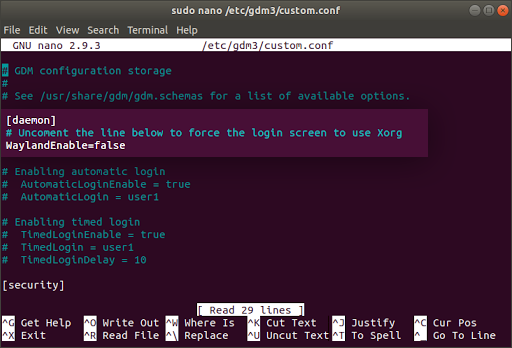
Note: The reboot functionality is supported only on RemotePC version 3.0.0 and above.
Can I access my Raspberry Pi computers with RemotePC?
Yes, you can remotely access your Raspberry Pi devices with the RemotePC application.
Visit the RemotePC download page to install and configure RemotePC package on your Raspberry Pi devices.
Do I need to pre-authorize RemotePC in Mac OS Mojave for remote access?
Yes, Mac OS Mojave requires user consent for applications to access privacy sensitive data. Hence you need to grant accessibility permissions to RemotePC, in order to remotely access your computers.
To pre-authorize RemotePC,
- Choose 'Open System Preferences' from the popup which appears when you try to remotely access a Mac or from the Apple menu. You will be redirected to 'Security and Privacy' preferences.
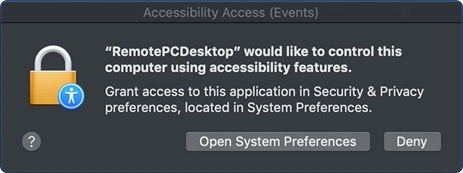
- Select 'Accessibility' under 'Privacy' pane.
- Click
 and provide system authentication to allow changes.
and provide system authentication to allow changes. - Select the checkboxes next to RemotePC related apps, e.g. RemotePCDesktop, RemotePCView.
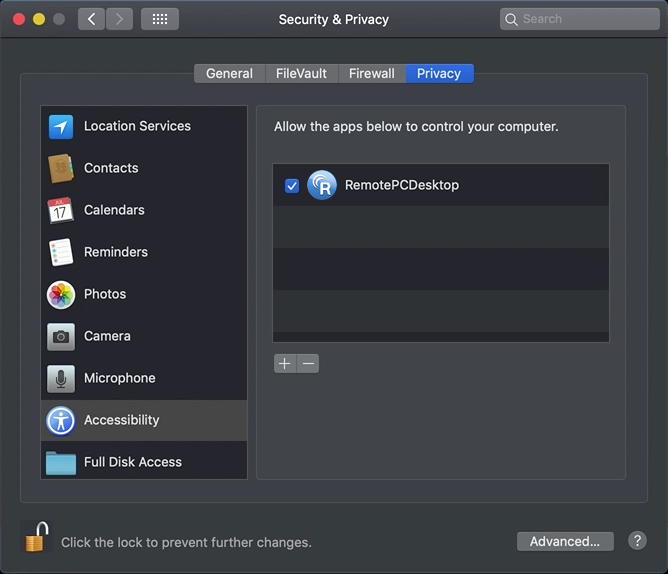
How do I pre-authorize RemotePC in Mac OS Catalina for remote access?
The Mac OS Catalina requires user consent for applications to record the content of their screen, even while using other apps. Hence you need to grant screen recording permissions to RemotePC.
To pre-authorize RemotePC,
- Open System Preferences and go to 'Security & Privacy' pane.
- Select 'Screen Recording'.
- Click
 and provide system authentication to allow changes.
and provide system authentication to allow changes. - Select the checkbox next to 'RemotePCDesktop'.
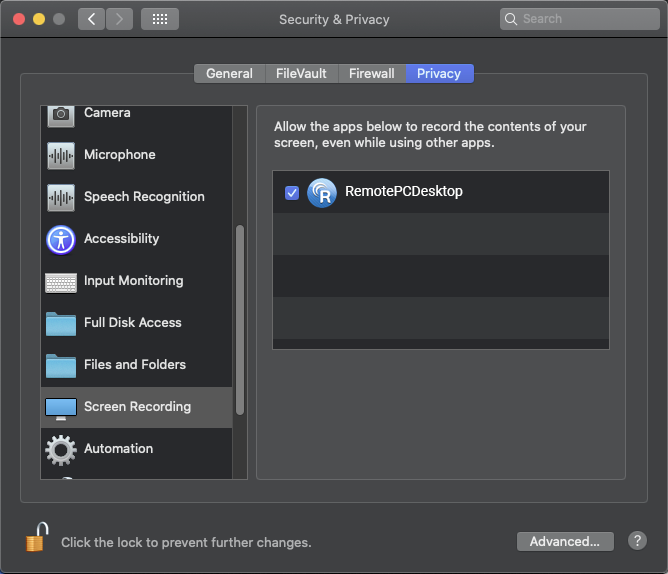
On trying to install the RemotePC Windows application I'm getting the message "The App You're Trying To Install Isn't A Microsoft-Verified App". What should I do?
If you try to install the RemotePC Windows application and get the notification 'The App You're Trying To Install Isn't A Microsoft-Verified App', you must change app recommendation settings to disable the notification.
To change the policy for installing apps:
- Click
 >
>  .
. - Click 'Apps' in the 'Settings' window.
- In 'Apps & Features', select 'Anywhere' in the 'Choose where to get apps' dropdown.
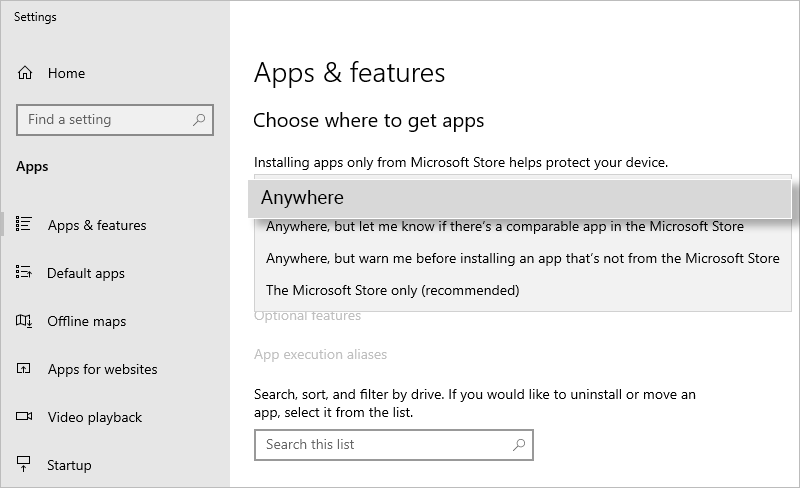
- Close the 'Settings' window to save the changes.
- If on installation, you get the message click 'Install anyway' to proceed.
Note: This setting can be modified by an administrator only.
How do I pre-authorize RemotePC in Mac OS Catalina for access to files and folders?
The Mac OS Catalina requires user consent for applications to access the content of their system, even while using other apps. Hence you need to grant screen recording permissions to RemotePC.
To pre-authorize RemotePC,
- Open System Preferences and go to 'Security & Privacy' pane.
- Select 'Files and Folders'.
- Click
 and provide system authentication to allow changes.
and provide system authentication to allow changes. - Select the checkbox listed under 'Host File Transfer'.
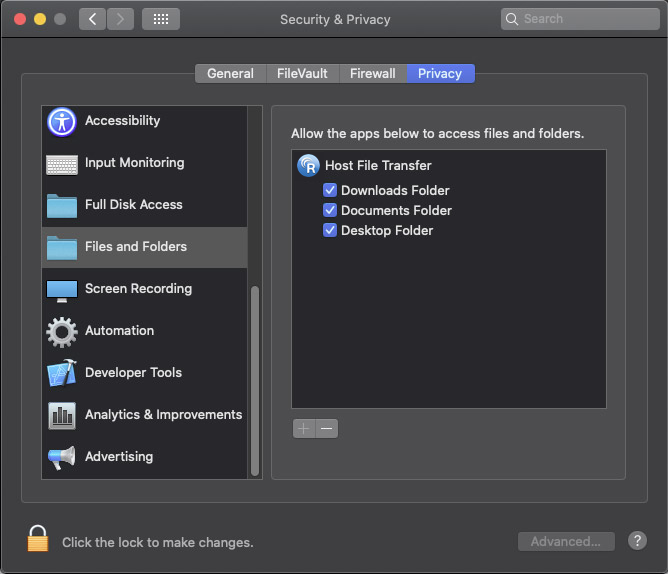
What are the options available in the RemotePC tray?
On installation, RemotePC creates a tray icon on your computer. Right-click the icon and a menu appears.
For Windows:
When logged in:
- RemotePC Web Access: Log in to your RemotePC web account
- Enable RemotePC: You can enable the RemotePC application
- Preferences: Manage wallpapers, themes, fonts etc and change the proxy settings
- Proxy Settings: Configure the proxy settings to use the RemotePC application
- RemotePC Help: An online help guide for RemotePC
- Send Error Report: Contact RemotePC support team for queries, suggestions or feedback
- About RemotePC: View your RemotePC version, its date of installation, etc.
- Exit: Exit from the application

When logged out:
- RemotePC Web Access: Log in to your RemotePC web account
- Preferences: Manage wallpapers, themes, fonts etc and change the proxy settings
- Proxy Settings: Configure the proxy settings to use the RemotePC application
- RemotePC Help: An online help guide for RemotePC
- Send Error Report: Contact RemotePC support team for queries, suggestions or feedback
- About RemotePC: View your RemotePC version, its date of installation, etc.
- Exit: Exit from the application
For Mac:
When logged in:
- RemotePC Web Access: Log in to your RemotePC web account
- Launch RemotePC: Opens the RemotePC application
- Preferences: Manage wallpapers, themes, fonts etc and change the proxy settings
- Proxy Settings: Configure the proxy settings to use the RemotePC application
- RemotePC Help: An online help guide for RemotePC
- Send Error Report: Contact RemotePC support team for queries, suggestions or feedback
- Check for updates: Allows you to check the available updates of the application
- Quit: Exits the application
When logged out:
- RemotePC Web Access: Log in to your RemotePC web account
- Launch RemotePC: Opens the RemotePC application
- Preferences: Manage wallpapers, themes, fonts etc and change the proxy settings
- Proxy Settings: Configure the proxy settings to use the RemotePC application
- RemotePC Help: An online help guide for RemotePC
- Send Error Report: Contact RemotePC support team for queries, suggestions or feedback
- Quit: Exits the application
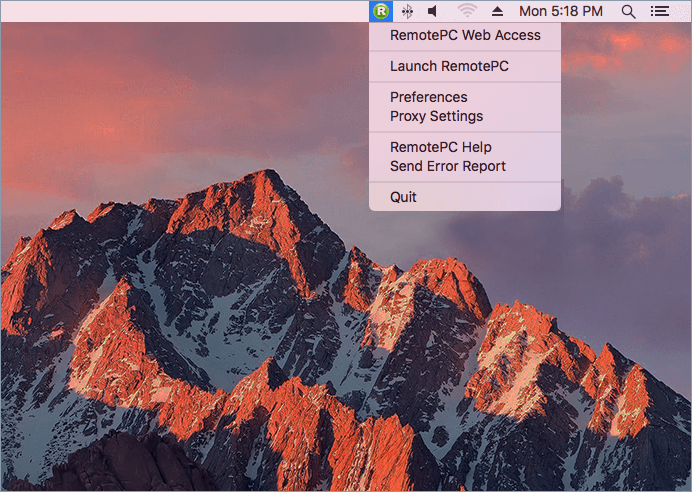
For Linux:
When application is launched:
- RemotePC Web Access: Log in to your RemotePC web account
- Enable/Disable RemotePC: You can enable or disable the RemotePC application
- Preferences: Enable 'Send Key Combination', lock remote screen on session end, and manage display quality
- RemotePC Help: An online help guide for RemotePC
- Open Log Files: View all the logs of the remote sessions
- Send Error Report: Contact RemotePC support team for queries, suggestions or feedback
- Exit: Exit from the application
When application is closed:
- Launch RemotePC: Opens the RemotePC application
- RemotePC Web Access: Log in to your RemotePC web account
- Preferences: Enable 'Send Key Combination', lock remote screen on session end, and manage display quality
- RemotePC Help: An online help guide for RemotePC
- Open Log Files: View all the logs of the remote sessions
- Send Error Report: Contact RemotePC support team for queries, suggestions or feedback
- Exit: Exit from the application
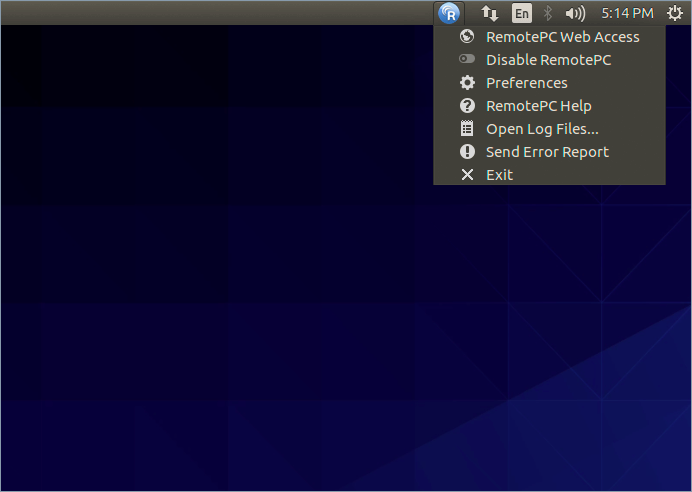
Note: For Linux Enterprise hosts, you can enter 'Remotepc-host help' in the Command-line interface to view the list of operation commands.
What are the different states of RemotePC?
There are three different states of RemotePC, which you can identify by the color your RemotePC tray icon turns into.
What should I do to restart a remote computer?
To restart a remote computer,
- Launch the RemotePC application and log in.
- Right-click the computer name and click 'Restart'.
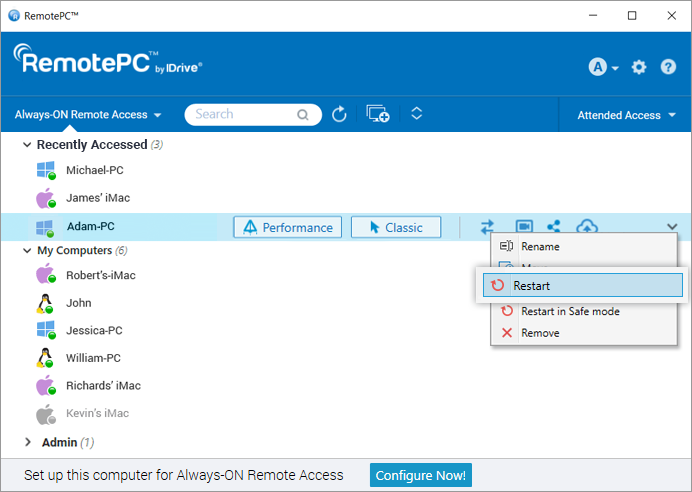
Your computer will go offline briefly, but once the computer becomes ready for remote connection, its status will change to online. Refresh the computer list manually to see the change.
Note: For Windows machines, an additional option to 'Restart in safe mode' will also appear.
What happens when I clone computers and VMs with RemotePC pre-installed?
RemotePC supports VMs or cloned machines and treats them like different machines/hosts. The cloned machines have the exact same configuration as the parent machines. To differentiate between the parent and clone machines, the clones have the same name as parent suffixed with 5 random digits.
Eg: If the parent machine "TEST-PC" is cloned, you will see 2 machines in the Computer list - "TEST-PC" and "TEST-PC_57648".
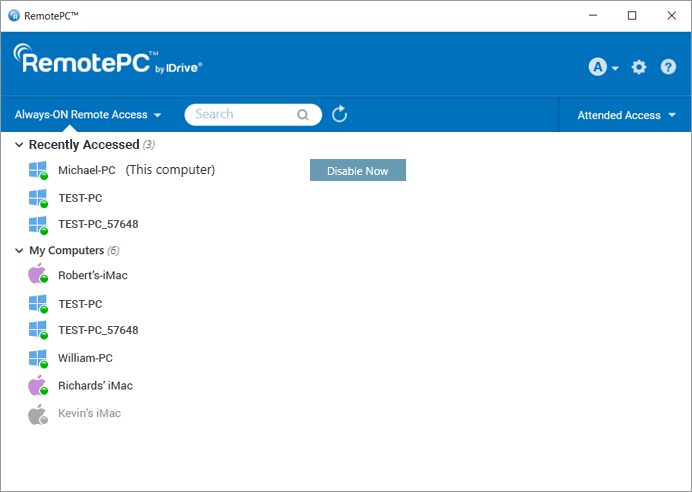
How do I get started with RemotePC?
For Windows and Mac:
To get started, download the RemotePC application and install it on your computer.
Once you setup and run the application, you will be redirected to the login page. Login to your RemotePC desktop app, and configure your computer for remote access.
For Linux:
To get started,
- Download the RemotePC for Linux package depending on the distribution of the Linux OS on your computer.
- Open the installer by double-clicking or right-clicking on the package.
- Select the package manager, e.g. Open with Ubuntu Software Center, to install it on your computer.
- You can also run the following commands to install the packages:
- For Debian:
sudo apt update
apt install ./remotepc.deb - For RPM:
sudo yum update
yum install ./remotepc.rpm
- For SUSE:
sudo zypper update
sudo zypper install ./remotepc-suse.rpm
Note: Use 'dnf' if 'yum' is not available. - For Debian: apt install ~/Downloads/remotepc.deb
- For RPM: yum install ~/Downloads/remotepc.rpm
Note: Use 'dnf' if 'yum' is not available. - On successful installation, launch the desktop app on your computer by either of the below:
- Type 'remotepc' from the command line.
- Click the RemotePC icon (Activities -> RemotePC)
- Accept the 'RemotePC License Agreement' (will appear at the first instance).
Alternatively, you can run the following commands:
You can now login and configure your Linux machine for Always-ON Remote Access.
How do I configure my computer for remote access?
To configure your computer for Always-ON Remote Access,
- Launch the RemotePC application and login.
- On the RemotePC home screen, click 'Configure Now!'.
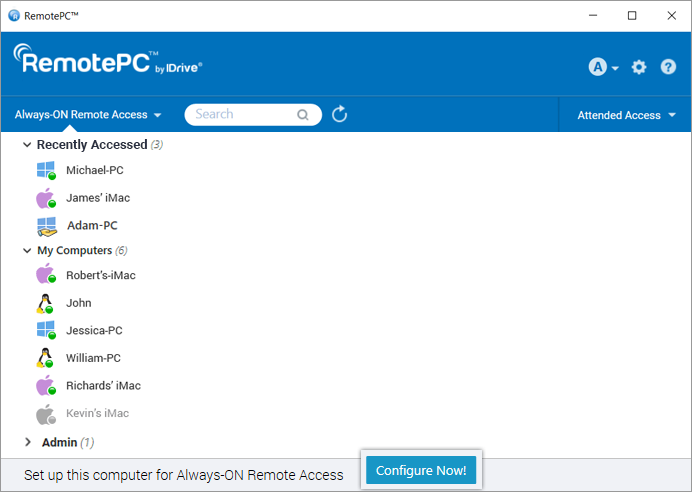
- Set 'Computer Name' and 'Personal Key' for your computer.
Note: As Personal Key is optional for Enterprise users, they will not be asked to assign a key while configuring a computer for the first time. However, if you want to set a Personal Key refer FAQ.
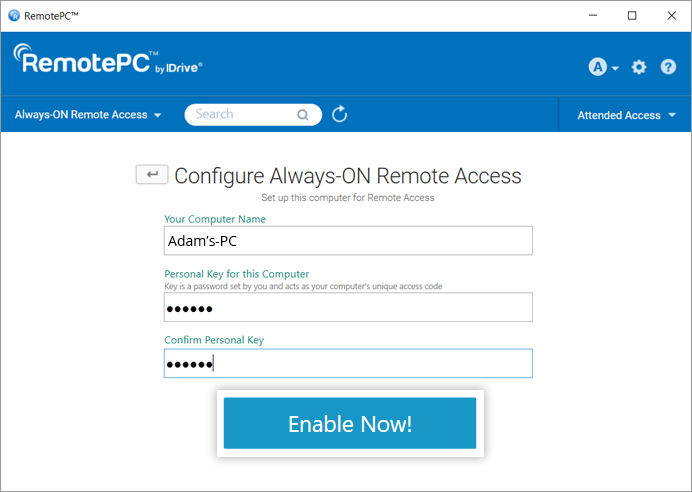
- Click 'Enable Now!'.
Your computer is now configured and will appear on the app home screen. You can access it from any distant computer.
How do I view and access my remote computers?
You need to configure your computers for remote access to connect to them from anywhere.
To access a configured computer,
- Launch the RemotePC application and log in.
- Your configured computers appear under 'Always-ON Remote Access'.
Note: You can filter the list of computers based on their status, by clicking .
. - Click 'Performance' against an online computer to connect via the Performance Viewer.
Alternatively, click 'Classic' to connect via the Classic Viewer.
If you wish to just transfer files, click .
. - Enter Personal Key and click 'OK'.
A remote access to the computer is established.
Can multiple simultaneous connections be established with the same remote computer?
Yes, multiple connections can be simultaneously established with the same computer.
If multiple connections are established, the status 'Remotely accessed by' will be displayed under 'Always-ON Remote Access' in the RemotePC application on that computer.
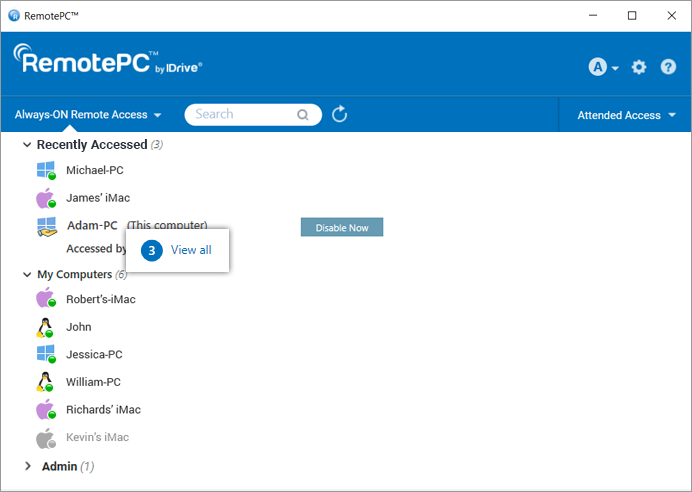
Click 'View All' to see the list of machines currently accessing the computer. Click ![]() to disconnect a connection or click 'Disconnect All' to disconnect all connections to the computer.
to disconnect a connection or click 'Disconnect All' to disconnect all connections to the computer.
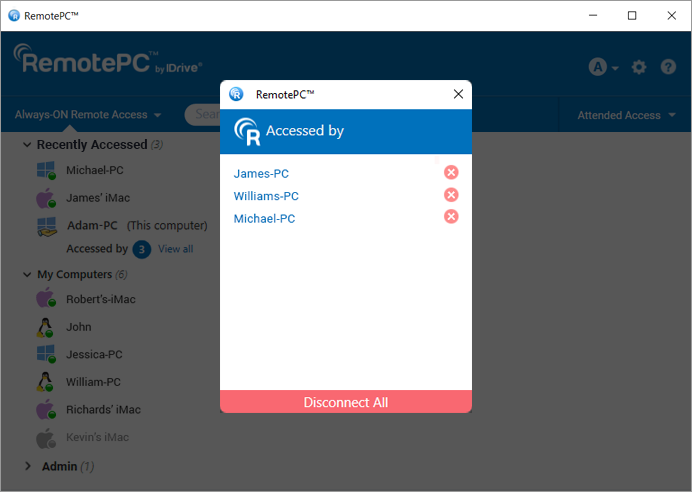
Connect via Performance or Classic Viewer and enter Personal Key (if configured) to establish remote connection simultaneously.
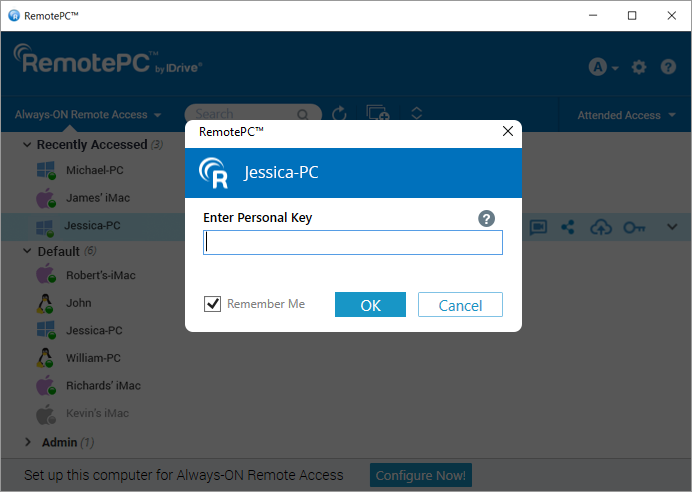
Can I remotely access a Mac from a Windows or Linux computer?
Yes, you can access your Mac from a Windows or Linux computer and vice-versa. You can also access a remote computer from your iPhone/iPad or Android device.
How do I connect to a specific RDP Session on a server?
To connect to a specific ongoing active RDP session on your remote Windows server machine using RemotePC,
System Requirements
- Windows Server
- RemotePC Application for Windows ()
Steps to Follow
- Launch the RemotePC application and login.
- Connect to the required online remote servers and establish connection.
- Click 'Connection' in the session toolbar and click 'RDP Session List'.
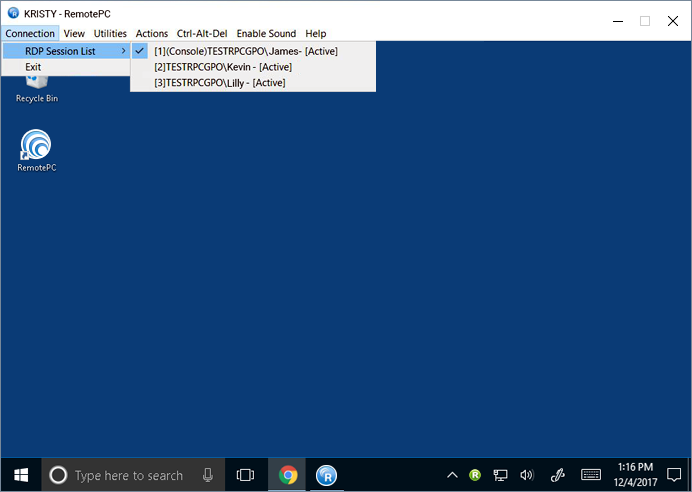
A list of all the live RDP session(s) will appear on screen.
- Click on the required RDP session to switch to it.
Note: This feature is only available for Windows.
What do the options under 'Always-ON Remote Access' tab signify?
'Always-ON Remote Access' tab displays the list of computers configured for remote access, and their current status. You can filter computers in the list based on their status.
All Computers - Displays the list of all the computers configured to your account.
Online - Displays the list of computers that are ready for remote session.
In Session - Displays the list of computers which are in an active remote session.
Offline - Displays the list of computers that either do not have any active Internet connection or the remote access configuration has been disabled on it.
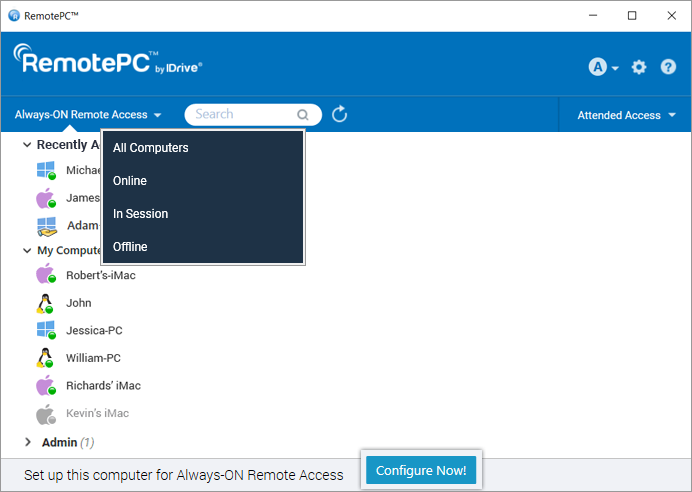
I forgot the Personal Key of my computer. How can I reset it?
To reset the Personal Key,
- Launch the RemotePC desktop application on the computer you wish to reset the key.
- Log in to your account.
- Right-click the computer name, and click 'Edit/Remove Personal Key'.
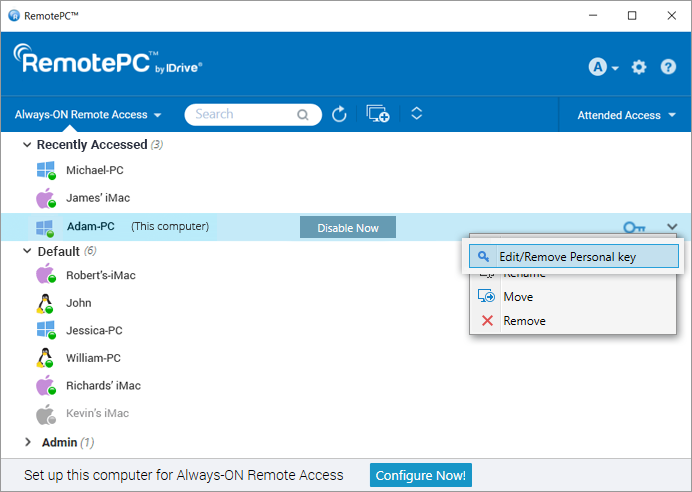
- Enter the new Personal Key and confirm the same.
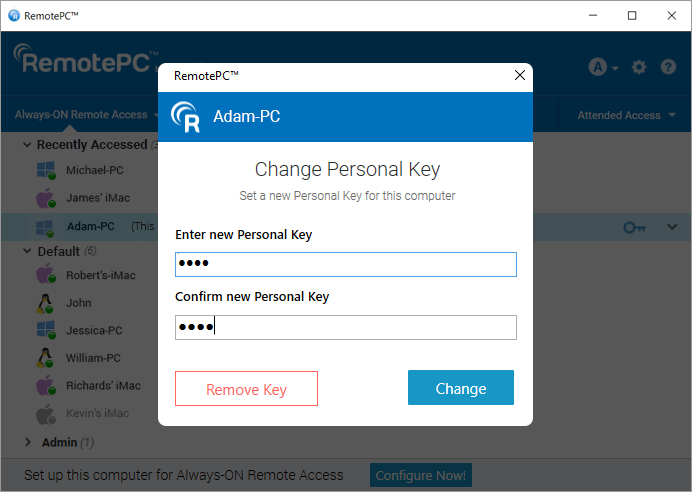
- Click 'Change'.
Alternatively, you can also reset the Personal Key by disabling the Always-ON Remote Access for the computer, and then reconfiguring it again. To disable and reconfigure,
- Click 'Disable Now' displayed against your computer name in the 'Always-ON Remote Access' section.
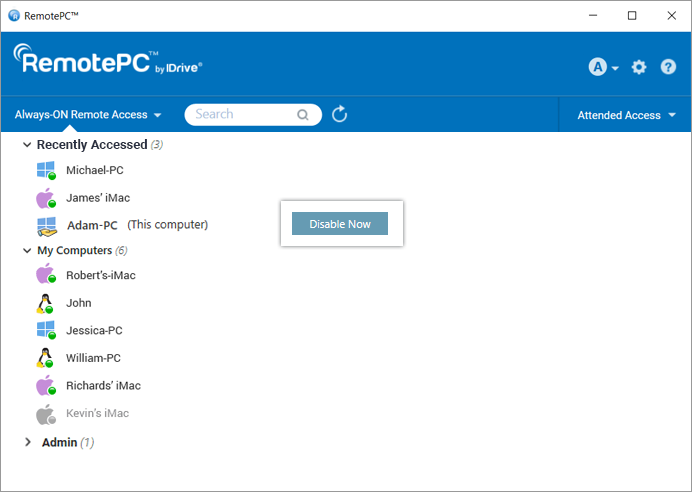
- Click 'Yes' in the confirmation window.
- Once 'Always-ON Remote Access' is disabled, click 'Configure Now!' on the home screen.

- Enter the new Personal Key and confirm the same.
- Click 'Enable Now!'.

How do I clear stored personal key credentials from the desktop application?
To clear stored credentials for a computer,
- Launch the RemotePC application and log in. Your configured computers appear under 'Always-ON Remote Access'.
- Right-click on any online or in-session computer under 'Always-ON Remote Access' and click 'Clear Credentials'.
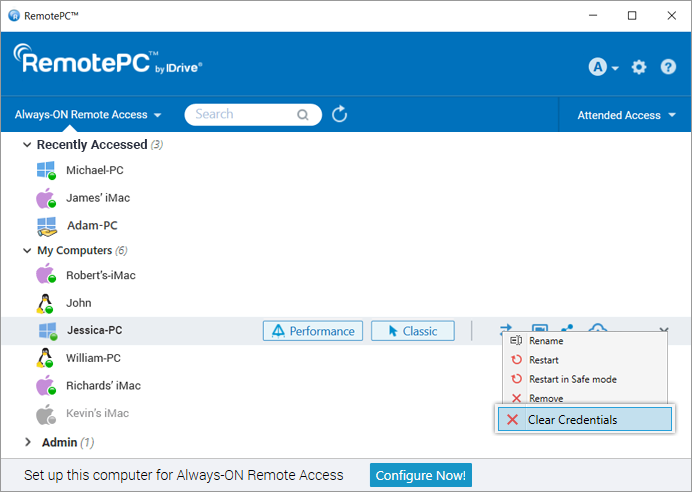
- Click 'Yes' to confirm. The saved credential for the computer will be cleared.
To clear credentials for all the computers,
- Log in to the RemotePC application.
- Click
 displayed on the top-right corner.
displayed on the top-right corner. - Go to the 'Advanced' tab.
- Under 'Clear Credentials' click 'Clear'.
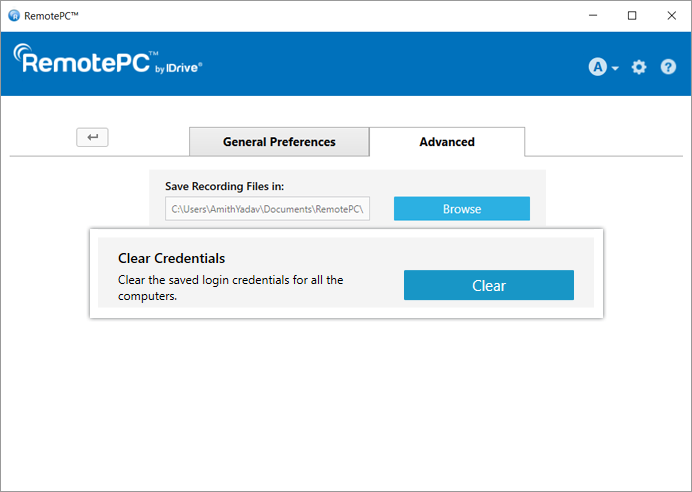
- Click 'Yes' to confirm. All saved computer credentials will be cleared.
How do I disconnect a remote session on a Linux machine?
During a remote session, go to the application menu and click 'Connection'. Click 'End Session' to disconnect the session.
Can I share a computer with my users?
Yes, users of SOHO and Team plan accounts can share a configured computer with other users for remote access.
To share a computer, click 'Share' corresponding to the required computer, enter the email address of the intended RemotePC users, and click 'Share'.
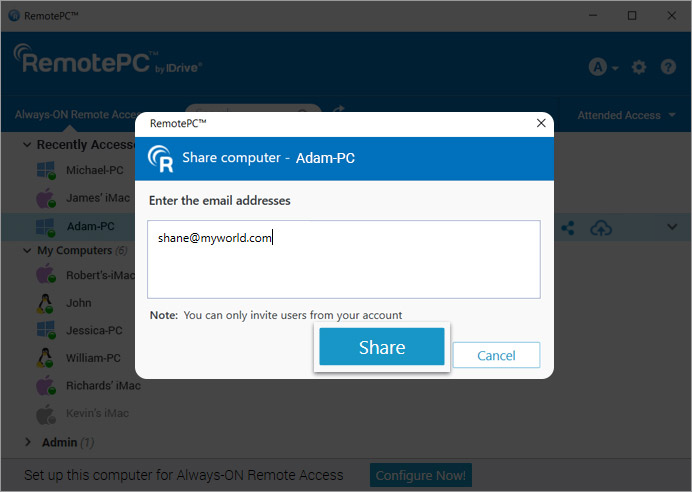
The recipients will be able to remotely access the shared computer.
Note:
- You can share a computer only with users from your RemotePC account.
- Users will only be able to access the shared computer remotely. They will not be able to make any modifications to the computer settings.
To stop sharing a computer with a particular user, click 'Share' to open the 'Share Computer' popup, and click 'Remove' next to the user.
To stop sharing the computer with all users, click 'Remove All'.
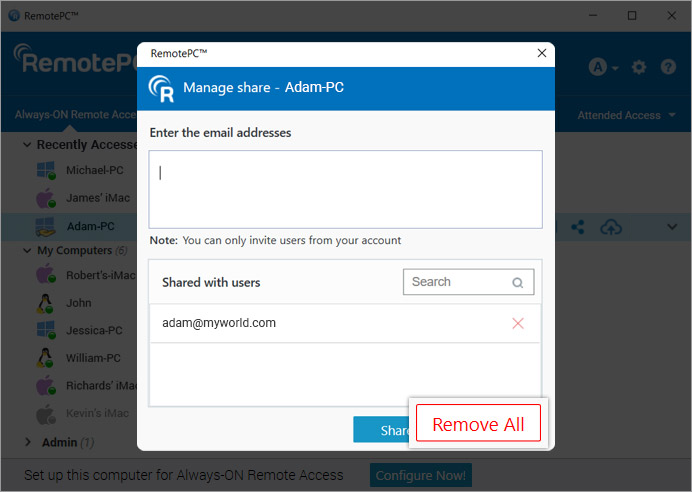
Can I scale the remote computer's desktop screen to fit within my local computer window?
Yes, you can scale the remote computer's desktop screen to fit within your local computer window, as by default the RemotePC desktop screen does not auto fit to your local computer window.
For Windows:
To scale the remote computer desktop screen within your local computer window,
- Launch the RemotePC application and log in.
- Connect to an online remote computer and establish connection.
- From the application menu, go to 'View'.
- Click 'Best Fit'. This will resize the remote computer desktop screen to fit within the local computer window.
You can also scale the remote computer's desktop screen to fit your local computer screen. From the application menu, go to 'View' and click 'Full Screen'.
For Mac and Linux:
To scale the remote computer desktop screen within your local computer window,
- Launch the RemotePC application and log in.
- Connect to an online remote computer, and establish connection.
- From the application menu, go to 'View' -> 'Scaling'.
- Click 'Best Fit'. This will resize the remote computer desktop screen to fit within the local computer window.
- To revert, click 'Scaling' -> 'Original Size'.
To view the remote computer desktop screen in Full Screen, from the application menu, go to 'View' and select 'Enter Full Screen'.
Can I switch between multiple monitors of the remote computer?
Yes. If your remote computer has more than one monitor, the RemotePC app allows you to switch between multiple screens.
For Windows,
- Launch the RemotePC application and log in.
- Connect to an online remote computer, and establish connection.
- On the application menu, click 'Switch Monitor' to switch between multiple monitors of the remote computer.
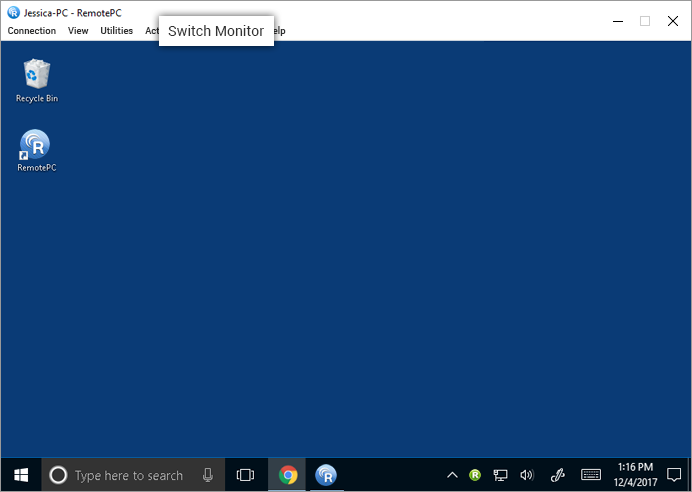
For Mac,
- Launch the RemotePC application and log in.
- Connect to an online remote computer, and establish connection.
- Click
 on the top-right corner of the screen to switch between multiple monitors.
on the top-right corner of the screen to switch between multiple monitors. 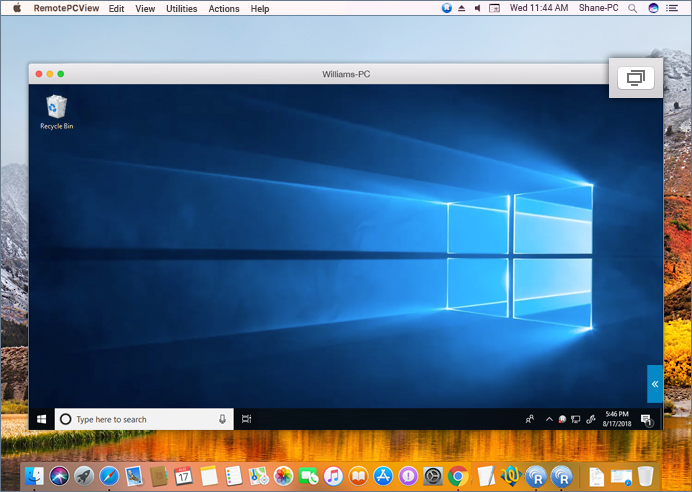
You can also view a single monitor of the remote computer. From the application menu, go to 'View' and click on the required monitor to view that individual monitor. You can also change the screen resolutions for individual monitors from here.
Does RemotePC support multi screens (monitors)?
If you are remotely accessing a device with multiple monitors, RemotePC allows you to view multiple remote screens in a single screen at the same time, or view each monitor on a different screen.
- To view each monitor on a different screen, from the application menu, go to 'View' and click 'All Monitors (Multiple Window)'. Each monitor of the remote computer will appear on a different screen and individual monitors can be accessed by clicking the respective screen.
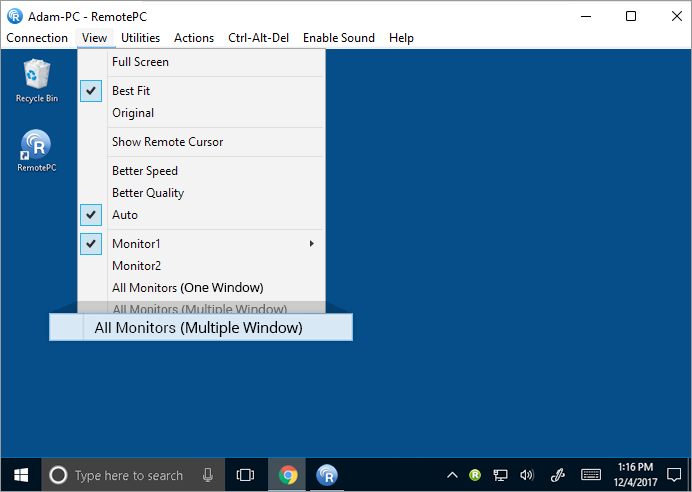
- To view all the monitors in single screen, from the application menu, go to 'View' and click 'All Monitors (One Window)'. All the screens of the remote computer will appear in the same screen.
For Linux:
- To view all the monitors on a single screen, from the application menu, go to 'View' and click 'Monitors' -> 'Show All Monitors'. All the screens of the remote computer will appear on the same screen.
- To view an individual monitor, go to 'View', click 'Monitors' and select the monitor you wish to view.
Can I transfer files between computers?
Yes, you can transfer files/folders between local and remote computers or vice versa. Make sure the latest versions of RemotePC application is installed on both the computers.
There are two ways to transfer files between any remote and local computer:
- During a live remote session, go to the application menu; click 'Utilities' -> 'File Transfer'.
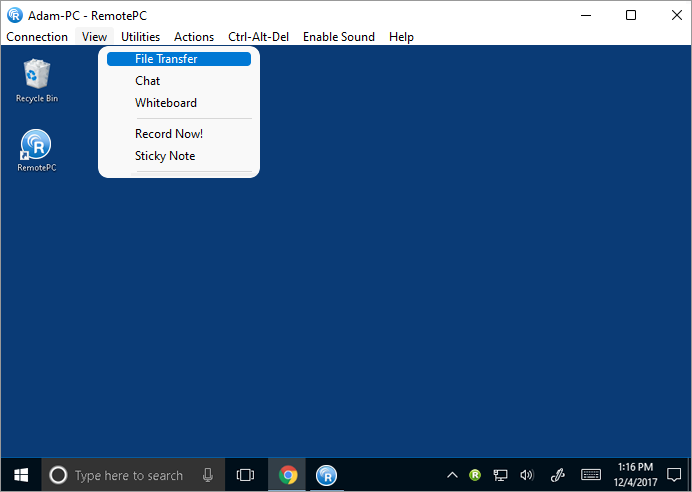
- On the 'Always-ON Remote Access' tab, click on a computer name, enter the key and click
 .
.
How do I transfer files / folders without starting a remote session?
To transfer files / folders without starting a remote session,
- Launch the RemotePC application and login.
- Hover on the online computer you wish to connect for file / folder transfer session, and click
 .
. 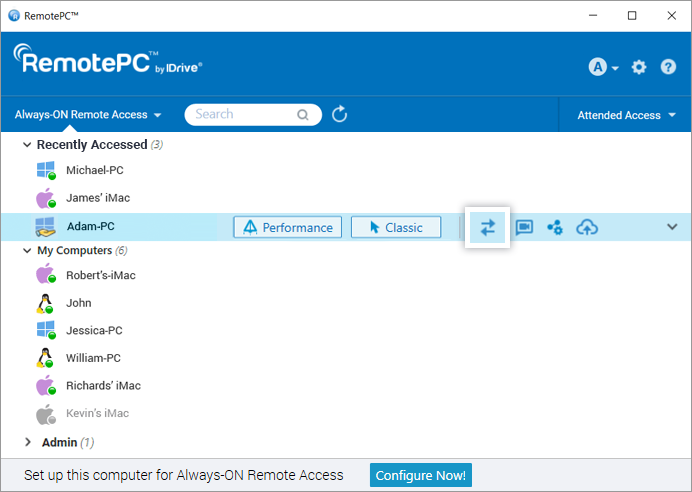
- Enter Personal Key and click 'OK'.
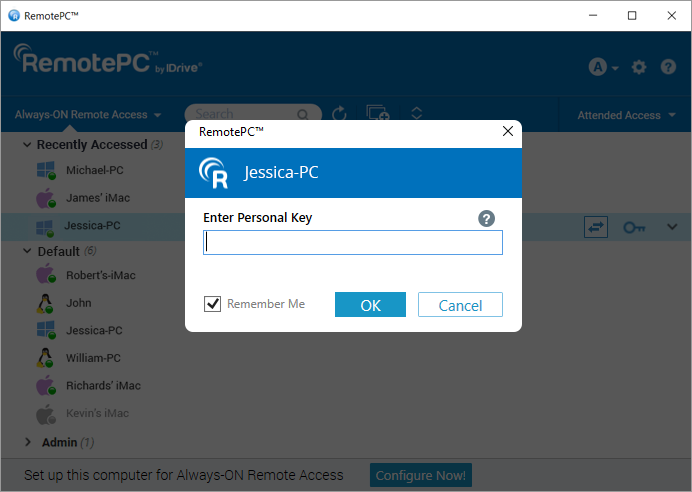
- The File Transfer window appears.
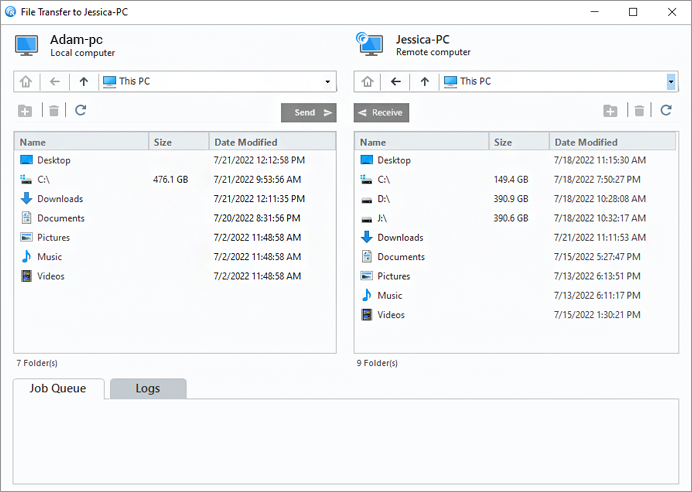
- To send files / folders from your local to remote computer, from the Local Computer drop-down menu, select files / folders you want to send, and click
 .
. - To receive files / folders from the remote to your local computer, from the Remote Computer drop-down menu, select files / folders, and click
 .
. - The progress of the transfer is shown in the 'Status' section.
Can I chat during a remote session?
Yes, you can chat with your partner at the remote end during a remote session.
To start a chat,
- Launch the RemotePC application and log in.
- Connect to an online remote computer, and establish connection.
- From the application menu, go to 'Utilities'.
- Click 'Chat'. The Chat screen appears.
- Enter your message in the 'Type your chat below:'/'Enter your text below' field and click 'Send'.
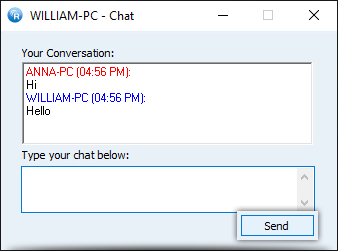
Note: The conversation between the local and remote computer is displayed in 'Your Conversation'/'Your chat conversation' field.
Can I video chat with remote users?
Yes, you can chat via video with remote users.
To begin the video chat,
- Launch the RemotePC application and log in.
- Click
 corresponding to the computer you wish to communicate with via video chat.
corresponding to the computer you wish to communicate with via video chat. 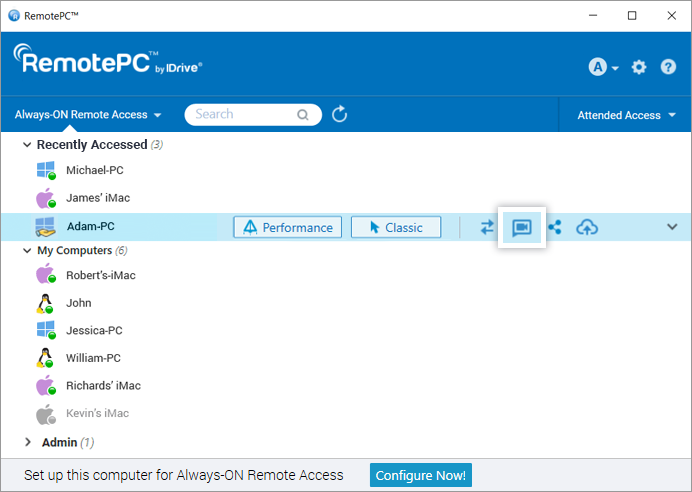
- The RemotePC Meeting screen will automatically launch. For the first time, you and the remote users will need to provide the permission to access the camera and microphone on your computers.
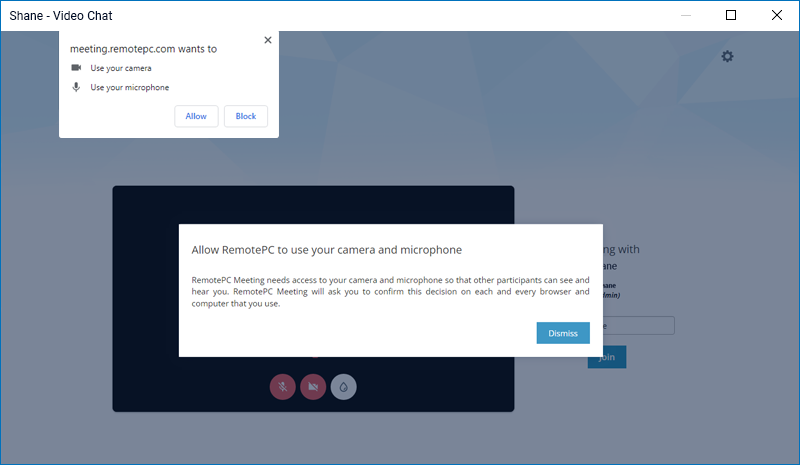
- Once the permission is granted, click 'Join' to begin the video call.
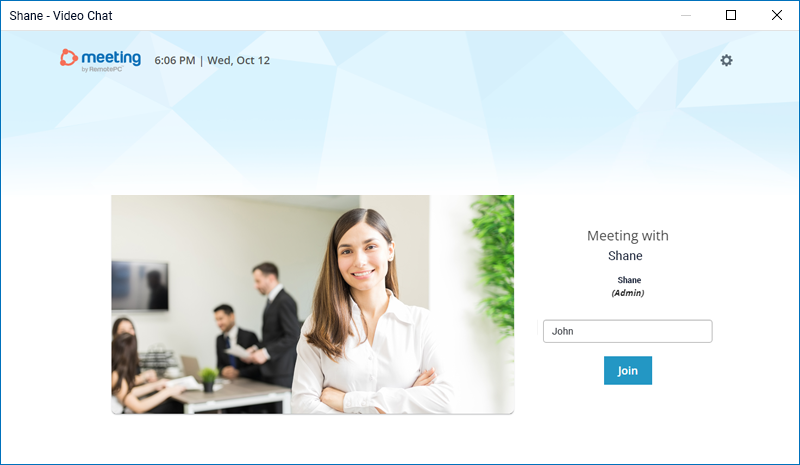
Learn how to use RemotePC Meeting.
Can I record the remote session activities?
Yes, you can record remote sessions and save them at any desired location on your local computer. These files can be stored and viewed later. RemotePC saves the recorded file in MP4 format and it can be played via Windows Media Player or VLC.
For Mac:
To record an active remote session,
- Launch the RemotePC application and log in.
- Connect to an online remote computer and establish connection.
- From the application menu, go to 'Utilities' -> 'Recording'.
- Click 'Start Recording'.
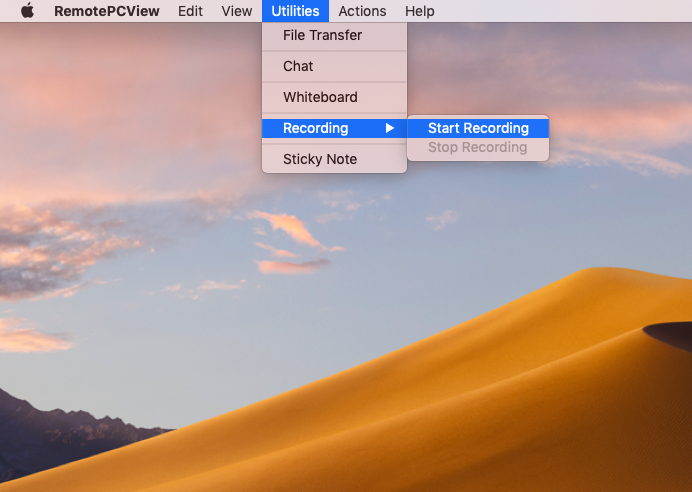
To stop the recording,
- From the application menu, go to 'Utilities' -> 'Recording'.
- Click 'Stop Recording'.
- Provide a name for the file, enter tags, choose a path, and click 'Save'.
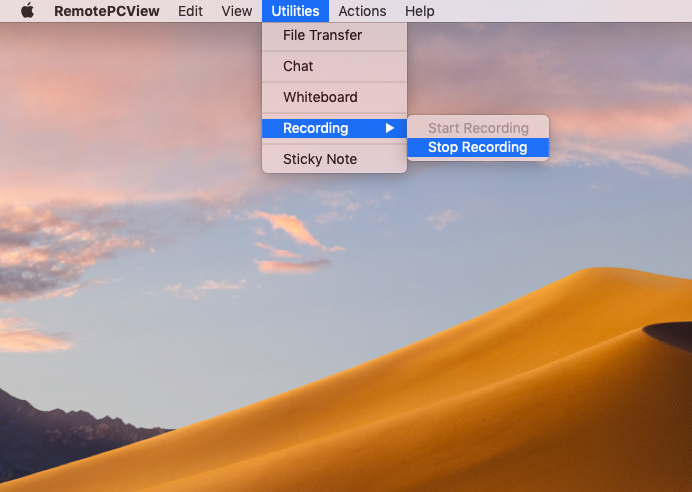
For Windows:
To record an active remote session,
- Launch the RemotePC application and log in.
- Connect to an online remote computer and establish connection.
- From the application menu, go to 'Utilities'.
- Click 'Record Now!'.
- Provide a name for the file, choose a path, and click 'Save'.
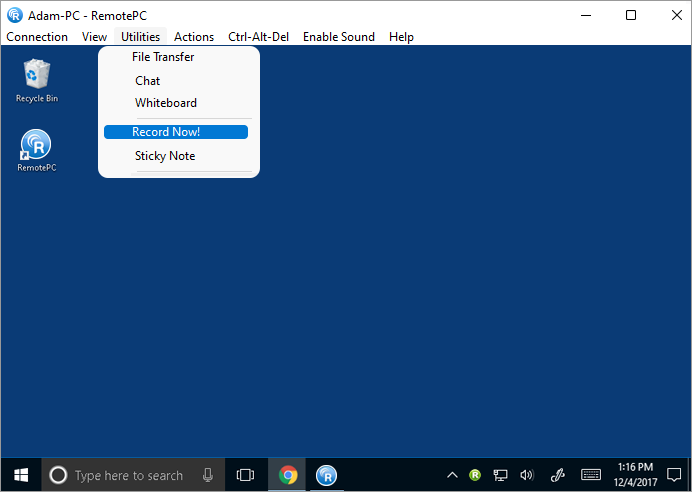
To stop the recording,
- From the application menu, go to 'Utilities'.
- Click 'Stop Recording'.
- Provide name for the file, select the particular path and click 'Save'.
Can I make notes on my remote computer screen? If yes, how?
Yes, you can make notes on your remote computer screen with the help of the 'Sticky Note' feature.
To enable sticky note,
- Launch the RemotePC application and log in.
- Connect to an online remote computer, and establish connection.
- From the application menu, go to 'Utilities'.
- Click 'Sticky Note'.
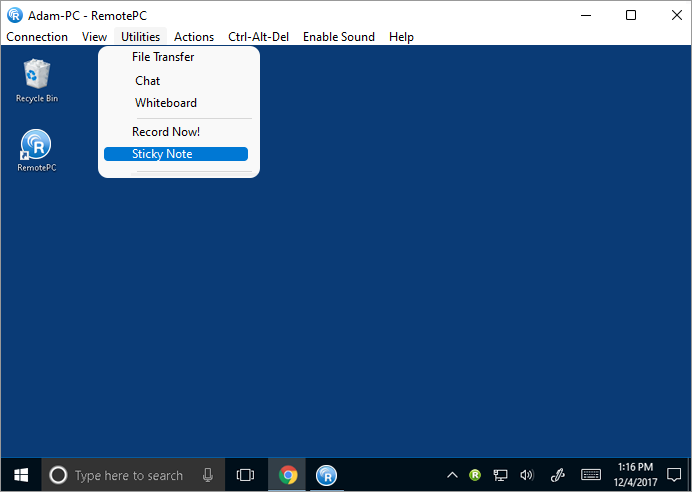
You can save and view the same after the remote session ends, in an offline mode. To save a note on your local computer, click  on the Sticky Note window, choose the destination folder, and click 'Save'.
on the Sticky Note window, choose the destination folder, and click 'Save'.
Note: This feature is not available for Linux to Linux connections.
How do I use Whiteboard during a remote session?
With Whiteboard, you can draw on the remote screen during a session to collaborate effectively.
To use Whiteboard,
- Launch the RemotePC application and log in.
- Connect to an online remote computer, and establish connection.
- From the application menu, go to 'Utilities'.
- Click 'Whiteboard'. The Whiteboard panel will pop up on the screen.
You can choose from the following options:
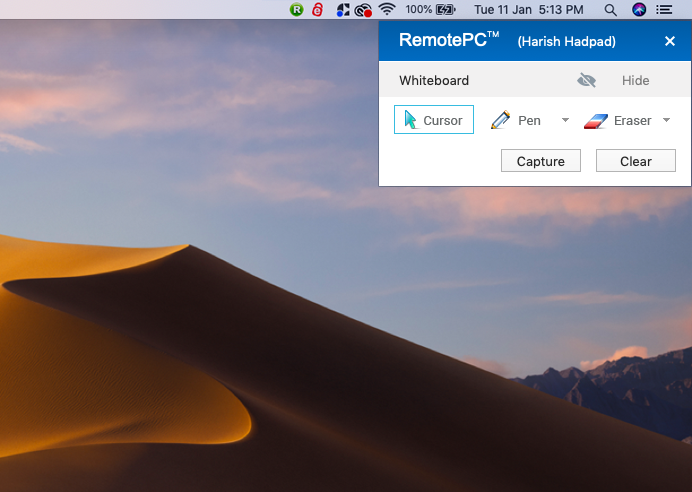
- Cursor: Selected by default, allows you to access the remote computer
- Pen: Select to draw on the remote screen. Choose a line width or color of your preference
- Eraser: Select to clear parts of the drawing on the screen. Choose a suitable width for the eraser
- Capture: Select to capture a screenshot and save it on the local computer
- Clear: Select to clear the entire drawing on the screen
Can I play music and watch video on the remote computer?
Yes, you can play music and watch video on the remote computer from your local computer.
For Windows:
Click 'Enable Sound' to play music or video. To mute audio, click 'Disable Sound'.
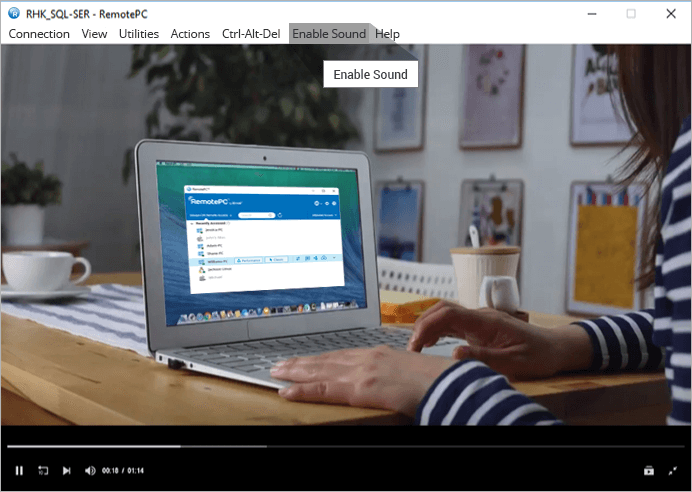
For Mac:
Click on  to play and
to play and  to mute audio.
to mute audio.
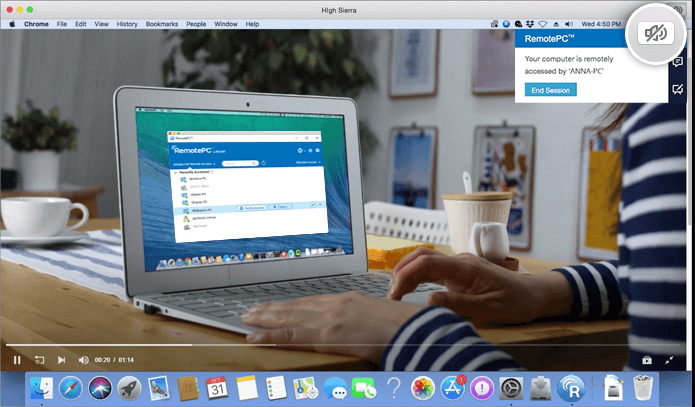
In Mac OS High Sierra and above, to play audio remotely you need to allow permission for RemotePC to install sound driver on your computer.
To enable during RemotePC installation,
- Click 'OK' when prompted to open System Preferences. You will be redirected to 'Security and Privacy' preferences.
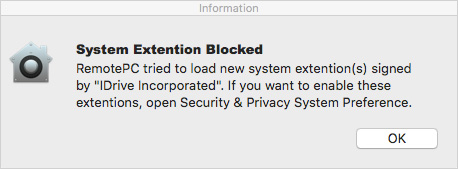
- Click 'Allow' under the 'General' pane to download the remote sound driver on your computer.
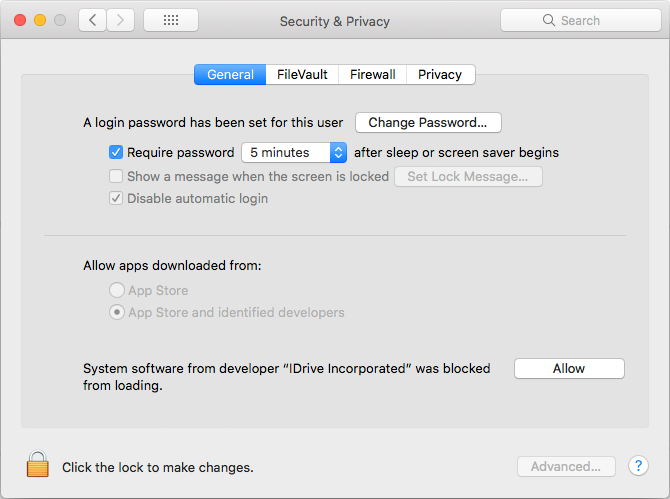
To enable later, navigate to 'Security and Privacy' in the Apple menu and click 'Allow' under the 'General' pane.
In case of Mac OS Mojave and above, RemotePC will need user permission to access the microphone and play audio remotely.
To allow microphone access,
- Click 'OK' when prompted for microphone access. You will be redirected to 'Security and Privacy' preferences.
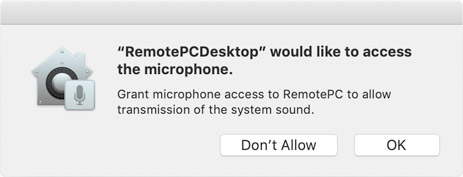
- Go to 'Microphone'.
- Click
 and provide system authentication to allow changes.
and provide system authentication to allow changes. - Select the checkbox next to 'RemotePCDesktop'.

For Linux:
- Go to 'Actions' from the application menu.
- Click 'Enable Sound' to play music or video.
The checkbox for the button will be marked when audio is enabled.
To mute audio, go to 'Actions' and click 'Enable Sound'. The check mark will disappear once the audio is disabled.
I can not hear audio from my remote Linux machine. What should I do?
To troubleshoot sound-related issues on your remote Linux machine,
- Install 'pavucontrol' via apt/yum.
This will install the 'Pulse Audio Volume Control' application on your computer. - Open the newly installed application.
- Establish a remote connection between your local and remote Linux machine and click 'Enable Sound'
- Go to the 'Recording' tab in the 'Pulse Audio Volume Control' application.
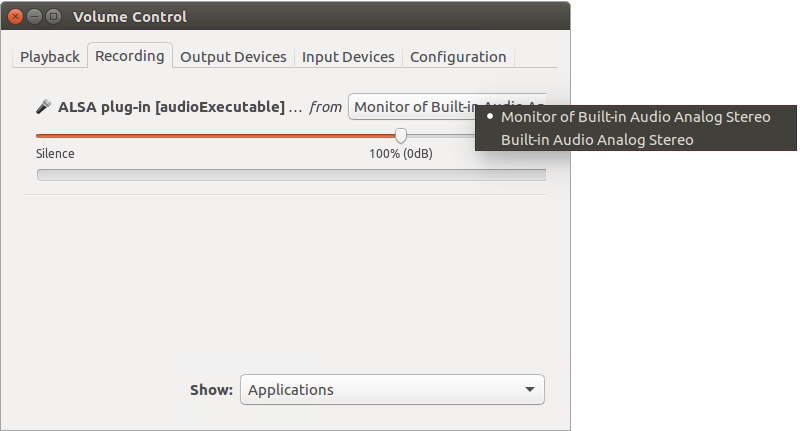
- Search for 'ALSA plug-in [audioExecutable]', and from the drop-down select 'Monitor of <audio device in your machine>'.
Note: Play sound functionality is not supported for Raspberry Pi devices.
Can I use keyboard shortcuts (such as Ctrl + C) on my remote computer during a remote session?
Yes, you can use keyboard shortcuts (such as Ctrl + C) on your remote computer during a remote session, by enabling the 'Send Key Combinations' feature.
To enable,
- Launch the RemotePC application and log in.
- Connect to an online remote computer, and establish connection.
- From the application menu, go to 'Actions'.
- Click 'Send Key Combinations' / 'Send Key Combination'.
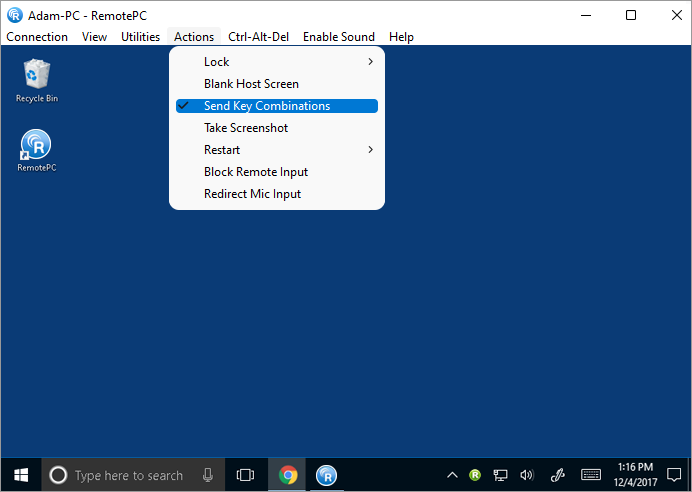
Can I lock the partner computer screen?
Yes, you can lock the partner computer screen during a remote session.
To lock,
- Launch the RemotePC application and log in.
- Connect to an online remote computer, and establish connection.
- From the application menu, go to 'Actions'.
- Click 'Lock' -> 'Lock now', to instantly lock the partner computer screen.
- Click Lock -> 'Lock on session end', to lock the partner computer screen as soon as the remote session ends.
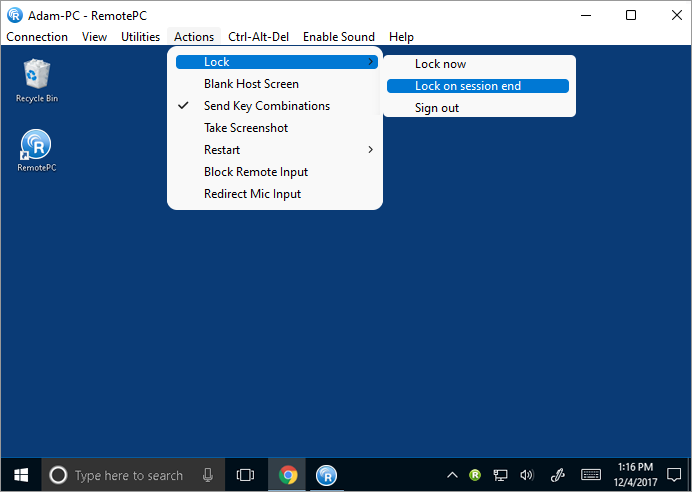
- Click 'Lock' > 'Sign out'/ 'Logout' to log off the current user profile.
You can also lock the remote computer using the Ctrl+Alt+Del command. When connected to a remote Windows system, the Ctrl+Alt+Del keyboard command will open the screen with Lock, Task Manager, Sign out, and related options. When connected to a remote Mac machine, the Ctrl+Alt+Del keyboard command will open the 'Force Quit Applications' window.
To send the Ctrl+Alt+Del command,
- Launch the RemotePC application and log in.
- Connect to an online remote computer and establish connection.
- From the application menu, go to 'Actions'.
- Click 'Ctrl+Alt+Del'.
Note: Locking remote computer screen is not supported for Raspberry Pi devices.
What is 'Blank Host Screen'?
In order to avoid others from viewing your remote computer screen during an ongoing session, you can black out the screen of your remote computer. The 'Blank Host Screen' feature is helpful in such scenarios where you do not have physical access to the machine to turn off the display of the remote computer.
To blank the host screen,
- Launch the RemotePC application and log in.
- Connect to an online remote computer, and establish connection.
- From the application menu, go to 'Actions'.
- Click 'Blank Host Screen'.
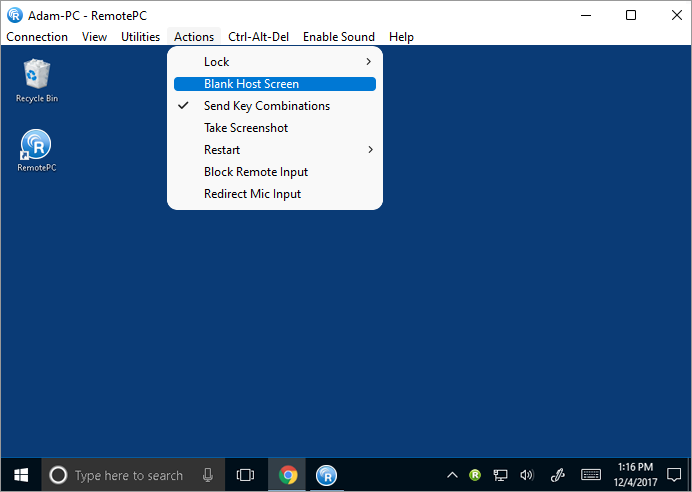
If you are using Windows 10 operating system, click 'Continue' when prompted to install the RemotePC monitor driver. Alternatively, you can also install the monitor driver from the 'Preferences' section.
Can I block keyboard and mouse input for remote computers?
Yes. While accessing a Mac or a Windows machine, you can prevent users at the remote end from using mouse and keyboard during a session with the 'Block Remote Input' option.
To block remote input,
- Launch the RemotePC application and log in.
- Connect to an online remote computer, and establish connection.
- From the application menu, go to 'Actions'.
- Click 'Block Remote Input'.
Note: Press CTRL+ALT+DEL on the remote computer to undo the action.
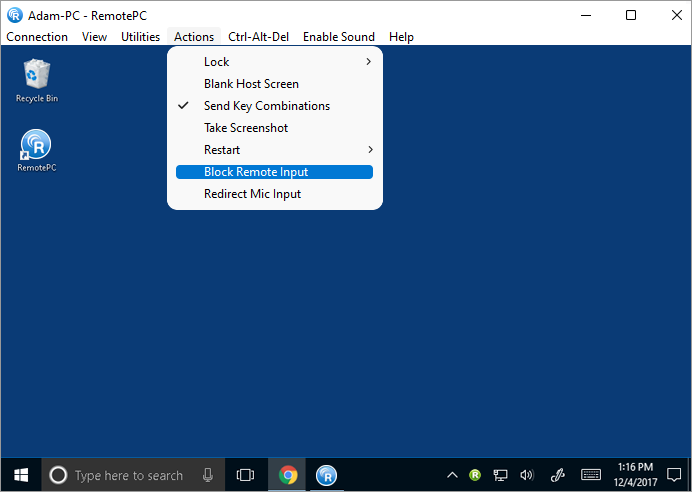
Can I redirect my local microphone input to the apps/services on the remote computer?
Yes, the microphone passthrough feature allows you to redirect your local microphone input to the remote computer/apps/ services as though you were sitting at the remote end. This feature allows you to join calls and use voice recording/dictation features over the remote session.
Note: The feature is currently available only for Classic Viewer/Windows computers. The local computer requires Windows 8 or above and the remote computer requires Windows 10 or above.
To redirect your microphone input during a remote session, click 'Actions' and select 'Redirect Mic Input'. This will install the RemotePC Virtual Device on the remote computer and the same will be selected as its microphone input.
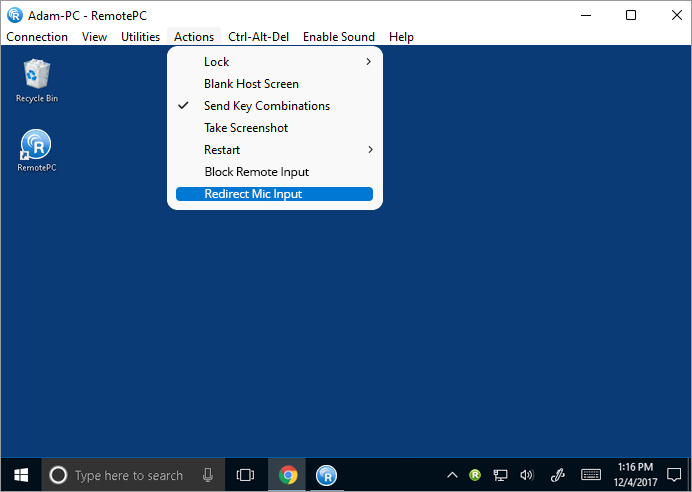
Use the 'Redirect Mic Input' option to mute and unmute the microphone passthrough during the remote session.
What is a Group? How can I create a Group?
A group is a collection of computers.
To create a computer group,
- Launch the RemotePC application and log in.
- Click
 displayed on the menu bar.
displayed on the menu bar. - Enter a name in the 'Create Group' popup.
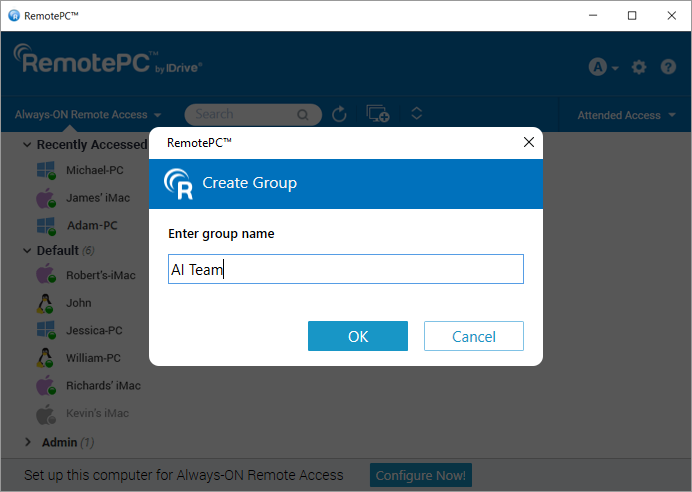
- Click 'OK'.
How can I rename a group name?
To rename a group name,
- Launch the RemotePC application and log in.
- Right-click a group name. From the options that appear, click 'Rename Group'.
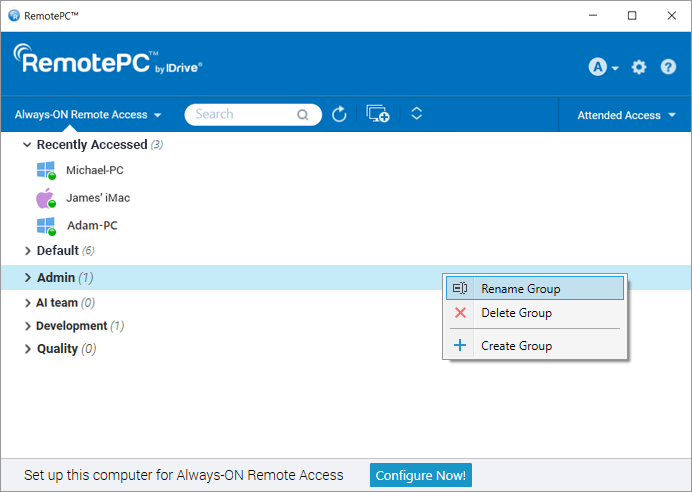
- Enter a new name in the 'Rename Group' field.
- Click 'OK'.
How do I delete a group?
To delete a group,
- Launch the RemotePC application and log in.
- Right-click a group name. From the options that appear, click 'Delete Group'.
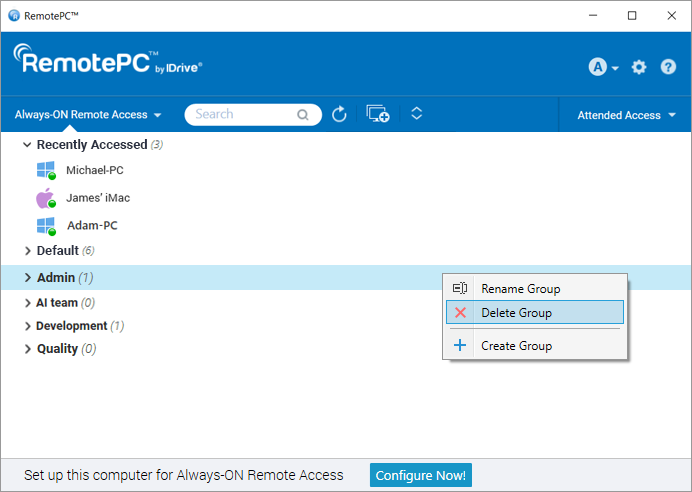
- A popup with an alert message will appear. Click 'OK' to delete the group.
On deletion of the group, all the computers will be moved to the Default group.
Is it possible to move computers between groups?
Yes, you can move computers between groups.
To move,
- Launch the RemotePC application and log in.
- Click a group name. The list of computers in the group will appear.
- Click a computer name, and in the options that appear, click 'Move'.
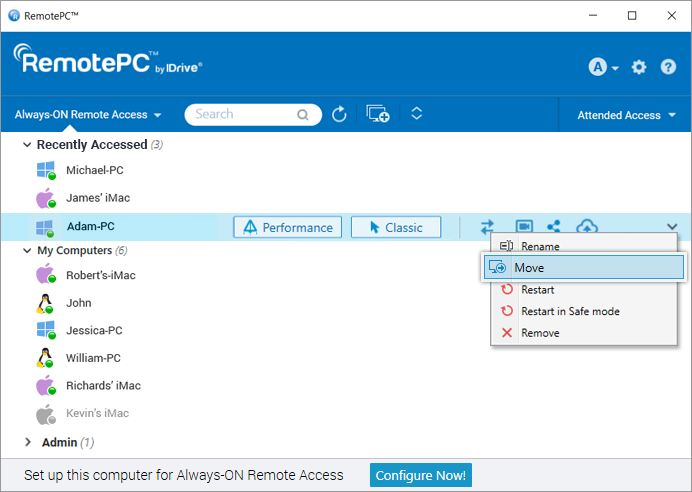
- In the 'Move Computer' screen, select the required group where you want to move the computer.
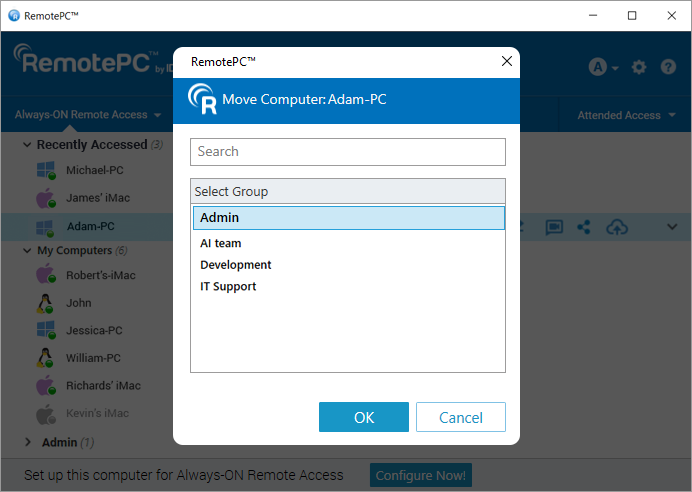
- Click 'OK'.
Alternatively, you can move a computer by dragging and dropping it to another group.
Can I remove or rename a computer from within a group?
Yes, you can remove or rename a computer from within a group.
To remove a computer,
- Launch the RemotePC application and log in.
- Click a group name. The list of computers in the group will appear.
- Click a computer name, and in the options that appear, click 'Remove'.
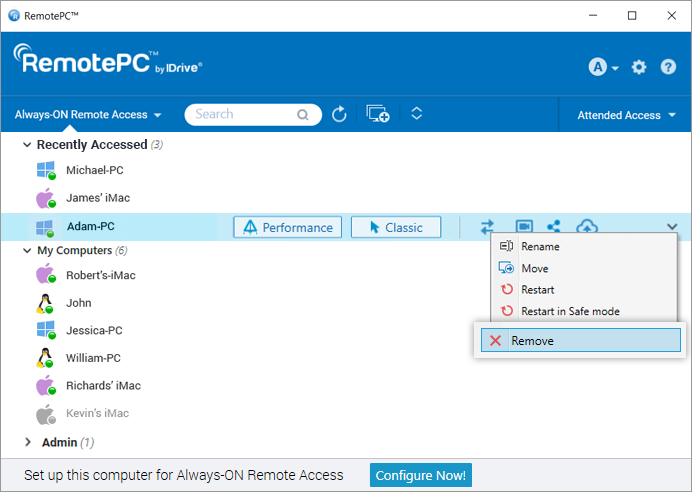
- Click 'Yes' in the popup that appears, to remove the computer from the group.
To rename a computer,
- Click a group name. The list of computers in the group will appear.
- Click a computer name, and in the options that appear, click 'Rename'.
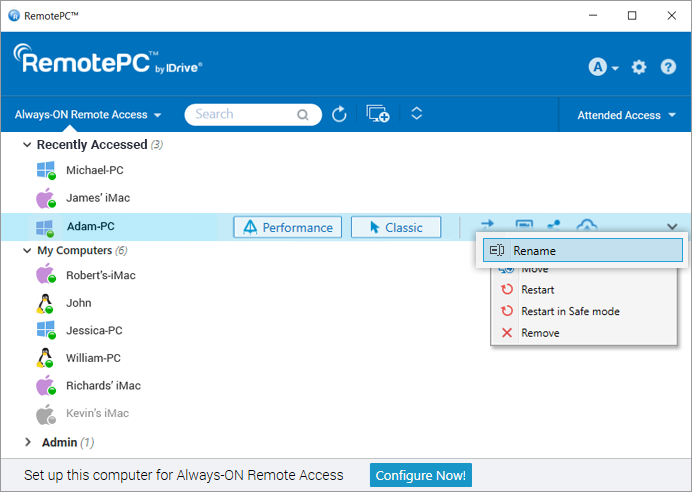
- Enter a new name in the 'Rename Computer' field.
- Click 'OK'.
Can I print documents on my remote computer?
Yes, with RemotePC you can print documents and images that are on your remote computers from wherever you are.
To print,
- Launch the RemotePC application and log in.
- Connect to an online remote computer, and establish connection.
- Select the file on the remote computer that is to be printed.
- Open the document and use Print command (or Ctrl+P) to print the selected document.
- Select 'RemotePC Printer' in the window and click 'Print'.
- Select a local printer when prompted, and click 'Continue'.
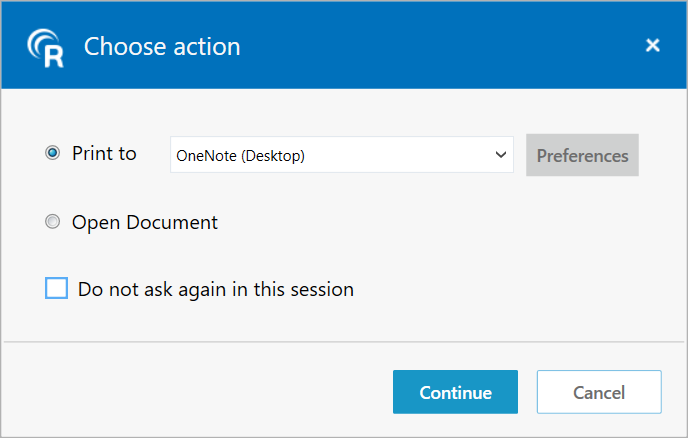
If a local printer is not configured, click 'Open Document' to view or save the document on the local computer.
Note:
- If more than one local printer is configured, the printing operation will be performed using the default printer.
- 'RemotePC Printer' will be displayed only during active remote sessions.
- RemotePC Printer is not supported for/in CLI (headless) Linux machines.
Can I use the RemotePC application via VPN (Virtual Private Network)?
Yes, you can use the RemotePC application via VPN. It allows you to create a secure connection between the local and remote computer and the connected computers act as if they are in the same network. Thus, users experience no lag during a remote session, and can work as if on their own computer.
To use RemotePC via VPN you need,
- An active Internet connection in both the local and remote computer
- VPN configured in both local and remote computer
- VPN enabled in the local computer
With the above requirements, RemotePC automatically detects the VPN and establishes a connection between the local and remote computer.
Can I end an ongoing session when my computer is getting accessed?
Yes, you can end an ongoing session when your computer is being remotely accessed. When a remote computer connects to your computer, a message appears on the bottom-right corner of the screen. You can end the session and restrict access to the remote computer by clicking 'End Session'.
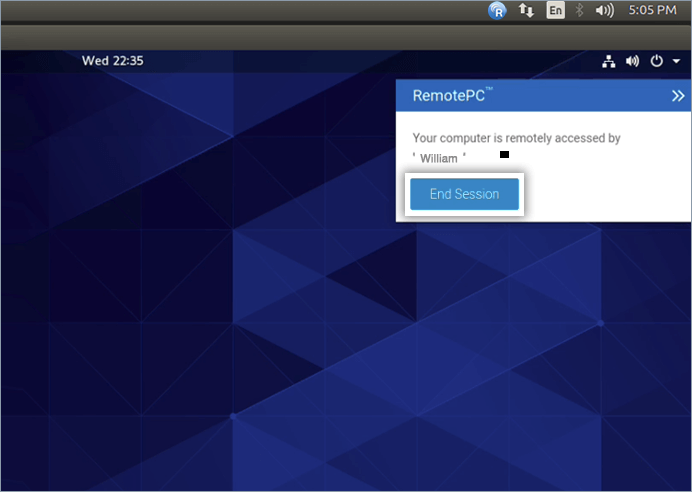
How can I rename or remove configured computers from my account?
To rename a configured computer,
- Launch the RemotePC application and log in.
- Right click on the computer name and click 'Rename'.
- Type a new name in the text field and click 'Rename'.
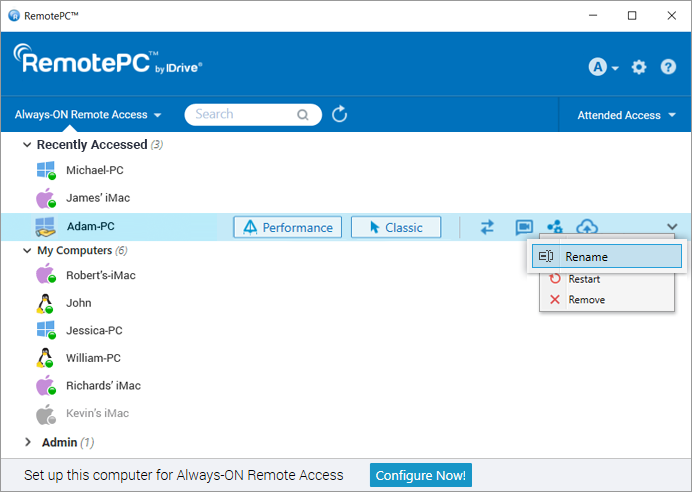
To remove a configured computer,
- Launch the RemotePC application and log in.
- Right click on the computer name and click 'Remove'.
- Click 'Yes' in the confirmation window.
You can only remove the computers that are online or offline.
Can I drag and drop files/folders between my local and remote computer?
Yes, you can drag and drop multiple files/folders between your local and remote computer during an ongoing session. Select the desired files/folders from the remote computer and drop them on to a specific location on your local computer, or vice versa. You can securely transfer files across multiple platforms i.e., from Windows to Mac or vice versa.
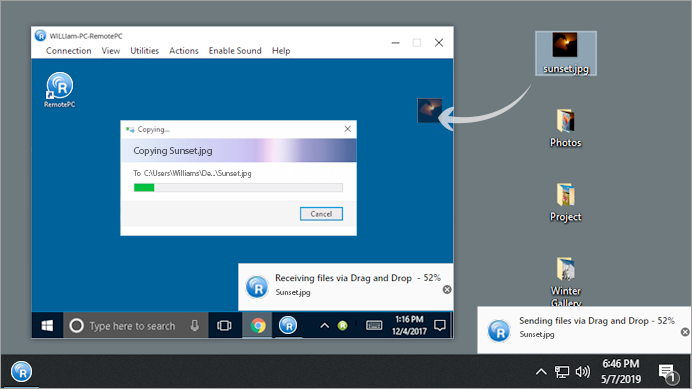
How can I configure Proxy Settings to use the RemotePC application?
To configure proxy settings, right-click the RemotePC tray icon and select 'Proxy Settings'.
The following are the available options:
- No Proxy: This is a default setting.
- Auto-detect: Select to get the proxy settings automatically.
- Manual: Select and configure the proxy server name, port and authentication details.
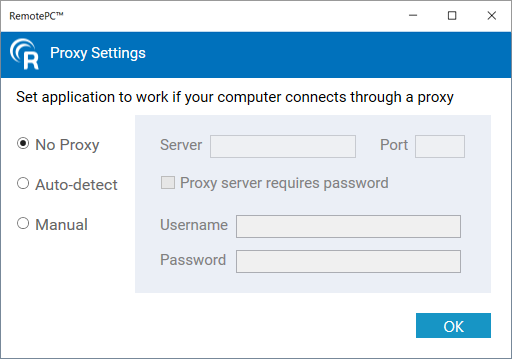
How do I uninstall RemotePC?
To uninstall RemotePC,
For Windows:
- Click
 .
. - Locate the RemotePC folder from the list of applications.
- Right-click on the RemotePC application and click 'Uninstall'. You will be redirected to 'Control Panel'.
- Right-click on 'RemotePC' and select 'Uninstall'.
For Mac:
- Go to 'File' > 'New Finder Window' > 'Applications' > 'RemotePCSuite'.
- Double-click 'RemotePCUninstaller'. A message will appear prompting you to start the uninstallation process.
- Click 'Yes' to proceed with the uninstallation.
For Linux:
- Go to the package manager, e.g. Open with Ubuntu Software Center.
- Locate the RemotePC folder from the list of applications.
- Click 'Remove' which appears on mouse hover.
A message will appear prompting you to enter the password of your computer. - Provide the password to complete the uninstallation process.
You can also run the following commands to remove and purge the packages:
| Action | Debian | RPM |
| Uninstall | apt purge remotepc/remotepcviewer/remotepc-host | yum remove remotepc/remotepcviewer/remotepc-host |
What is Wake-on-LAN (WOL) in RemotePC?
Wake-on-LAN in RemotePC lets you wake up your offline remote computers to establish a connection from anywhere. Enable WOL in the RemotePC application and turn on an offline remote computer using any of the following options:
- Through Local Network
- Through a Public IP
Learn more about hardware requirements and settings configuration needed to successfully enable WOL in Windows computers for WOL.
Note: This functionality is currently not supported for Mac.
How do I enable WOL in RemotePC?
Before performing the steps to enable Wake-on-LAN, ensure that the hardware requirements and settings configuration needed to successfully enable WOL are fulfilled.
To enable WOL through local network,
- Launch the RemotePC application and log in.
- Click 'Configure Now!' and configure your computer for remote access.
- Click
 displayed on the top-right corner.
displayed on the top-right corner. - Click 'Configure'.
- Select 'Wake-on-LAN through Local Network' from the 'Select option to wake up this computer via Wake-on-LAN' drop-down list.
- Click
 , select the computers you want to add as mediator computers and click 'Add'.
, select the computers you want to add as mediator computers and click 'Add'. Note: Ensure that the selected mediator computer is in the same network (LAN) as the local computer.
- Click 'OK'.
To enable WOL through a Public IP,
- Launch the RemotePC application and log in.
- Click 'Configure Now!' and configure your computer for remote access.
- Click
 displayed on the top-right corner.
displayed on the top-right corner. - Click 'Configure'.
- Select 'Wake-on-LAN through Public IP' from the 'Select option to wake up this computer via Wake-on-LAN' drop-down list.
- Enter a Public IP and port number in 'Address' and 'Port' fields respectively.
- Click 'OK'.
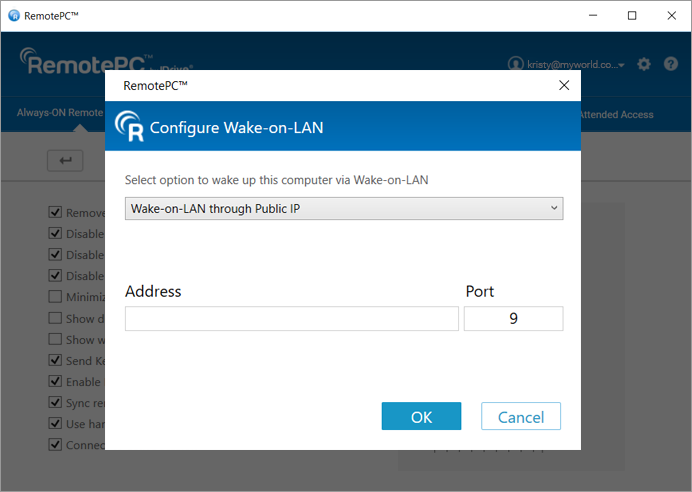
Before you enable WOL through a public IP, make sure the following requirements are met:
- Network Firewall (if any) should be configured to allow any UDP packet that is received for this Public IP and Port number.
- Router with this Public IP should be configured to forward any UDP packet that is received for this Port number to the system on which you wish to enable WOL.
Note: This functionality is currently not supported for Mac.
How do I wake up an offline remote computer via WOL?
To wake up an offline remote computer after enabling WOL,
- Launch the RemotePC application and log in.
- Click
 displayed next to the offline computer name to wake up that computer.
displayed next to the offline computer name to wake up that computer.
Note:
- Attended access feature and functions like switch monitor, file transfer, chat, record remote sessions, sticky notes, whiteboard, playing music/video during remote session, remote printing, drag and drop, and WOL are not available for connections via Linux machines.
- Functions like switch monitor, record remote sessions, and drag and drop, are not available for connections via Linux machines.
- Some options like session recording, remote sound, and send key combinations will not be available while using RemotePC™ Viewer Lite.
Source: https://www.remotepc.com/faq
0 Response to "How to Get Remote Access to a Pc for Continued Use"
Post a Comment